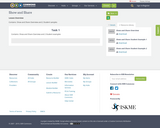
Contains: Show and Share Overview and 2 Student samples
- Subject:
- Educational Technology
- Elementary Education
- Material Type:
- Lesson Plan
- Author:
- Katie Shea
- Date Added:
- 05/22/2019

Contains: Show and Share Overview and 2 Student samples
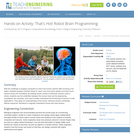
With the challenge to program computers to mimic the human reaction after touching a hot object, students program LEGO® robots to "react" and move back quickly once their touch sensors bump into something. By relating human senses to electronic sensors used in robots, students see the similarities between the human brain and its engineering counterpart, the computer, and come to better understand the functioning of sensors in both applications. They apply an understanding of the human "stimulus-sensor-coordinator-effector-response" framework to logically understand human and robot actions.
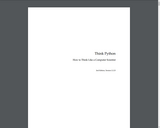
The goal of this book is to teach you to think like a computer scientist. This way of thinking combines some of the best features of mathematics, engineering, and natural science. Like mathematicians, computer scientists use formal languages to denote ideas (specifically computations). Like engineers, they design things, assembling components into systems and evaluating tradeoffs among alternatives. Like scientists, they observe the behavior of complex systems, form hypotheses, and test predictions.

Most work is processed through computers nowadays, like submitting reports or filling out forms. Therefore, typing skill is the prerequisite to these tasks. This motivational lesson about computers will help learners realize the necessity of using computer can be of help to them personally and for school or work, and will provide a basic understanding of some basics of computer skills.

Student pairs first act out the instructions a robot is given with one person providing instructions and the other person following the instructions. This activity helps students understand how robots are programmed and with what type of precision commands must be given. Then students program LEGO MINDSTORMS(TM) NXT taskbots to navigate a simple maze. The goal is to teach students that robot computers simply follow directions exactly as they are given, thus one must be very clear and logical with programming instructions.
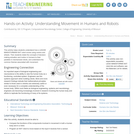
This activity helps students understand how a LEGO MINDSTORMS(TM) NXT robot moves using motors and wheels. Then students relate the concepts of decision-making actuation and motion in humans to their parallels in mechanized robots, and understand the common themes associated with movement.
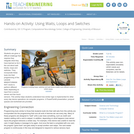
Students are given a difficult challenge that requires they integrate what they have learned so far in the unit about wait blocks, loops and switches. They incorporate these tools into their programming of the LEGO MINDSTORMS(TM) NXT robots to perform different tasks depending on input from a sound sensor and two touch sensors. This activity helps students understand how similar logic is implemented for other every day device operations via computer programs. A PowerPoint® presentation, pre/post quizzes and worksheet are provided.
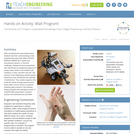
After completing the associated lesson, students test their understanding in two programming tasks that utilize LEGO MINDSTORMS(TM) NXT robots and sound/touch sensors. In the first challenge, students become acquainted with wait blocks by designing programs to simply make robots move forward until "hearing" a noise, and then turn left. The second, more challenging activity pushes students to fully understand the potential of wait blocks. They create programs that make the robots change speed several times when a touch sensor is pressed. Students gain practice in the iterative design-program-test-redesign process. A PowerPoint® presentation, pre/post quizzes and worksheet are provided.
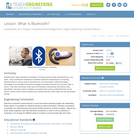
Students learn about electrical connections, how they work and their pervasiveness in our world. They consider the usefulness of wireless electrical connections for connecting electrical devices. Morse code is introduced as a communication method that takes advantage of on/off states to transmit messages by electrical bursts sent via wires, light or sound. They learn the Morse code rules and translate a few phrases into Morse code. Specifically, they learn about a wireless connection type known as Bluetooth that can be used to control LEGO robots remotely from Android devices, which leads into the associated activity.
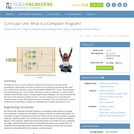
Through four lesson and four activities, students are introduced to the logic behind programming. Starting with very basic commands, they develop programming skills while they create and test programs using LEGO MINDSTORMS(TM) NXT robots. Students apply new programming tools move blocks, wait blocks, loops and switches in order to better navigate robots through mazes. Through programming challenges, they become familiar with the steps of the engineering design process. The unit is designed to be motivational for student learning, so they view programming as a fun activity. This unit is the third in a series. PowerPoint® presentations, quizzes and worksheets are provided throughout the unit.
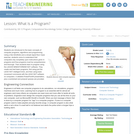
Students are introduced to the basic concepts of computer programs, algorithms and programming. Using a few blindfolds and a simple taped floor maze exercise, students come to understand that computers rely completely upon instructions given in programs and thus programs must be comprehensive and thorough. Then students learn to program using the LEGO MINDSTORMS(TM) NXT software. They create and test basic programs, first using just the LEGO NXT intelligent brick, and then using basic movement commands with the LEGO NXT software on computers. A detailed PowerPoint® presentation, plus a worksheet and pre/post quizzes are provided.
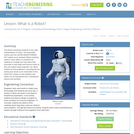
This lesson introduces students to the major characteristics of robots. The associated activity uses the LEGO MINDSTORMS(TM) NXT system as an example. Before studying robots in more detail, it is important for students to consider the many items they encounter in their daily lives that are robots so they can explore ways engineers can utilize robotics to solve problems in everyday life.The activity also serves as an introduction to the LEGO NXT system so that students may utilize it as an educational tool in subsequent lessons and activities.
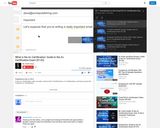
In this A+ Certification video we take a look at the IT Certifications, A+ Certifications, and how to pass the CompTIA A+ Certification.
--------------
Visit Us On The Internet:
-YouTube: https://www.youtube.com/mrfordsclass
-Twitter: https://twitter.com/mrfordsclass
-Facebook: https://www.facebook.com/mrfordsclasslearning
-Google+: https://plus.google.com/+mrfordsclass/posts
-Instagram: http://instagram.com/mrfordsclasslearning
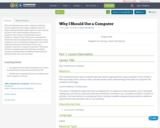
This motivational lesson about computers will help learners appreciate how using a computer can be of help to them personally and for school or work, and will provide a basic understanding of the parts of a computer and computer terminology.
Learner Audience / Primary Users
This lesson is intended for adults who have no background in or experience using computers, are at a 6th grade reading level, and need to understand why they should learn how to use a computer. and what a computer is and does. The lesson will be in a small group format. Having an available computer would provide an additional opportunity for demonstration, but is not necessary.

computer
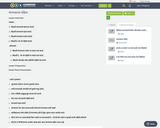
रसग्रहण : १ : विद्यार्थी संगणकाची संकल्पना सांगतो. २ : विद्यार्थी संगणकाचे महत्त्व सांगतो.३ : विद्यार्थी संगणकाचे उपयोग सांगतो.४ : विद्यार्थी ई- मेल ची माहिती सांगतो. अभिव्यक्ती : १ : विद्यार्थी संगणकाचा उपयोग स्व शब्दात स्पष्ट करतो. २ : विद्यार्थी ई – मेल ची माहिती स्व शब्दात स्पष्ट करतो. ३ : विद्यार्थी ऑनलाईन प्रवेश प्रक्रियेची माहिती स्पष्ट करतो.